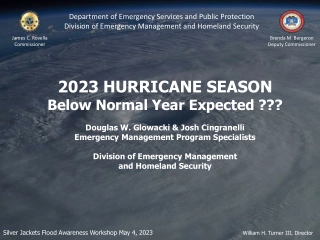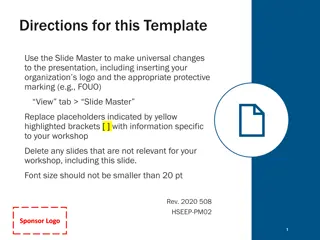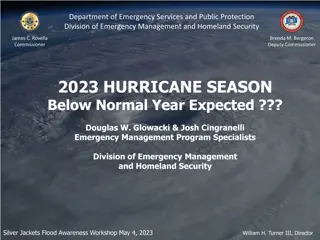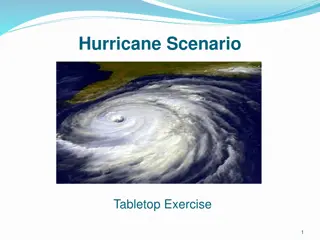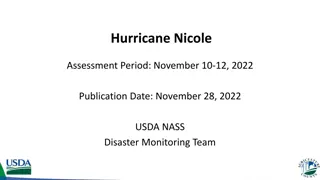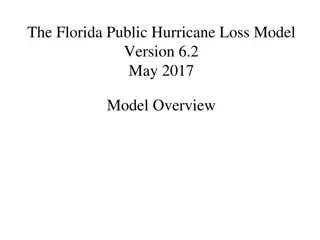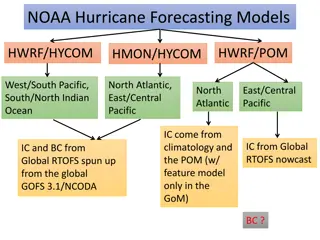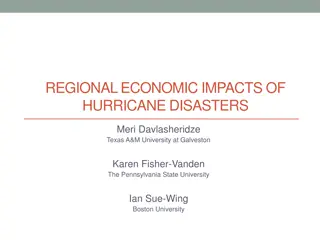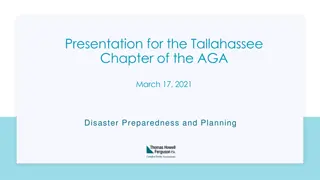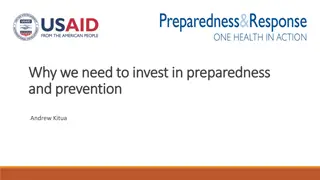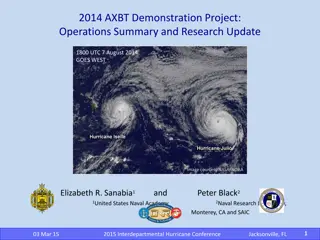Proactive Hurricane Preparedness: A Comprehensive Guide
Learn how to proactively protect your property from hurricanes with a detailed Hurricane Emergency Response Plan (HERP). This guide covers the essential phases of emergency management, including mitigation/prevention, planning, response, and recovery. Develop key roles and responsibilities, understand hurricane categories, and prepare effectively before, during, and after the storm to safeguard your property.
Download Presentation

Please find below an Image/Link to download the presentation.
The content on the website is provided AS IS for your information and personal use only. It may not be sold, licensed, or shared on other websites without obtaining consent from the author.If you encounter any issues during the download, it is possible that the publisher has removed the file from their server.
You are allowed to download the files provided on this website for personal or commercial use, subject to the condition that they are used lawfully. All files are the property of their respective owners.
The content on the website is provided AS IS for your information and personal use only. It may not be sold, licensed, or shared on other websites without obtaining consent from the author.
E N D
Presentation Transcript
CHTA STORM PREP SERIES: PROACTIVE PROPERTY PROTECTION Prepared By: Kevan N. Dean Director of Emergency Preparedness, Atlantis Resort, Nassau, Bahamas
Proactive Property Protection Introduction The Hurricane Season How To Prepare Four Phases of Emergency Management Leadership - HERP Crises Manager Teamwork - HERP Crises Management Team (CMT) BEFORE, DURING AND AFTER THE STORM Helpful HERP Support Documents Recap and Questions
About Hurricanes Hurricane Season starts June 1stand ends November 30th. Hurricane Categories
(Watches and Warnings) Tropical Storm Watch: An announcement that tropical-storm conditions are possible within the specified area. Hurricane Watch: An announcement that hurricane conditions are possible within the specified area. Because outside preparedness activities become difficult once winds reach tropical storm force, watches are issued 48 hours in advance of the anticipated onset of tropical-storm-force winds. Tropical Storm Warning: An announcement that tropical-storm conditions are expected within the specified area. Hurricane Warning: An announcement that hurricane conditions are expected within the specified area. Because outside preparedness activities become difficult once winds reach tropical storm force, warnings are issued 36 hours in advance of the anticipated onset of tropical-storm-force winds.
How To Prepare While it must be understood it is impossible to predict or plan for every conceivable type of emergency. A Hurricane Emergency Response Plan will provide basic information to safely and successful meet the overall objectives of your operations. Hurricanes are unique events that fortunately allow you time to prepare but your reaction time weighs heavily on how effectively you prepare. The Key is to have a plan IMPORTANT Plans are great but execution is what counts.
Developing a Hurricane Emergency Response Plan (HERP) The Goal: The HERP goal is to ensure that comprehensive plans, process and procedures are in place to respond to Hurricanes and by default, other Emergencies. The HERP plan will also identify key roles and responsibilities of individuals and departments or groups of team members. This HERP plan will seek to respond to basic emergencies and follows the four phases of emergency management which include: Mitigation/Prevention Planning Response Recovery
MITIGATION/Prevention MITIGATION The action of reducing the severity, seriousness, or painfulness of something. PREVENTION The action of stopping something from happening or arising on of stopping. Mitigation/Prevention Key Points/Examples Mitigation - If a room is susceptible to flooding, then take the precaution to place sandbags to restrict water intrusion. Prevention - If it is necessary, build a barrier wall in the room to prevent water intrusion or relocate the contents of the room completely in an effort to eliminate the risk if determined to be critical enough.
Planning Planning - The process of thinking about the activities required to achieve a desired goal. It involves the creation and maintenance of a documented plan. Mitigation/Prevention Key Points: Ensure that you stage appropriate assets in advance. Planning Ensure that you have human resource support Before, During and After a hurricane event.
Response Response: How quickly and effectively we react to a change in circumstance or situation. Key Point: Make sure you have the right compliment of volunteers in the right work assignments. Mitigation/Prevention Planning Consistently communicate with Employees and Guest about impacts where appropriate. Response Note: The more accurate information you are able to provide the less anxiety, confusion, you are likely to have.
Recovery Recovery: The actions required to return to a normal state of operation. Key Points: Storms tend to stress areas that are not normally stressed both physically in your facility and emotionally. Mitigation/Prevention Recovery Planning Take the time to fully access the readiness of your property and staff and in some cases your support services and systems. Response One way to achieve this to ensure that you have the right TEAM in place.
LEADERSHIP - Crises Manager (CM) The Crises Manager has the overall responsibility for the plan. The responsibility include but is not limited to: Developing and maintaining the written HERP Taking security measures to protect employees and property Integrating your HERP with any existing general emergency plans covering the building or work area occupied; Training designated employees in emergency response that could be associated with a hurricane emergency such as: Fire and Medical emergencies Ensuring that our facility meets all local fire, health, security, and building codes and regulations. Oversee policy or process revisions or creations Managing and actions and responsibility of the Crises Management Team (CMT)
TEAM- Crises Management Team (CMT) The CMT is comprised of designated departmental representatives which are to assist in the successful execution of the plan under the varying emergency conditions. This may include but is not limited to: Ensure that Policy and Procedures are in agreement with department s Standard Operating Procedure. Review and test the plan at various steps of implementation to improve the Response effectiveness and shorten the Recovery time. Keeps in constant communication with the Crises Manager Assist with the overall execution of the plan
The Plans Success Require Teamwork PUBLIC RELATIONS F&B MANAGER FINANCE CRISIS MANAGER SECURITY ENGINEERING CONSULTANT & OTHERS HUMAN RESOURCES INFO TECH
Before the Storm Before The Storm Review your country plan in relationship to your company plan Establish an effective communication plan Complete a photo/video inventory of your property prior to the season. Review updates and revision from previous season to ensure that they are still applicable in your current operations Test all Emergency Equipment and review critical parts, supplies (water, batteries, etc.) and equipment inventory. Raise any electrical or valuable items off the floor. Turn off or unplug lights and other electrical equipment. Remove pictures from walls and wrapped in plastic. Power down all computers and office equipment where applicable cover with plastic Move staff equipment in the exterior offices to the interior. Secure all exterior doors and windows. Remember any breech may result in significant damage. Back Up all critical files and documents Retrain volunteers to ensure that they understand their roles and responsibilities. Establish a Emergency Operating Center Identify a Post Storm Relief Team
During the Storm During the Storm Employees should monitor the condition from a safe shelter and limit movement. Operations should stay in content communication with their HERP Crises Management Team Leader and provide frequent update. Where possible, stay in communication with members of your team that may not be on property. HERP Crises Manager should be in communication with the appropriate Emergency Services, Government Agencies, Airlines and Tourism Organizations and Team Members. Identify any service limitations as a result of the limitation in advance have a documented work around. Be ready to mobilize teams to safely react to changing conditions
Evacuation and Sheltering Identify a safe location for both Employees and Guest to Shelter if required. Determine the most effective evacuation process for you: Floor Evacuation Building Evacuation Office Evacuation Review your organizations policy on compensation and rates in advance. Provide clear instructions to guest on the evacuation process and expectation. Ensure that shelters are as comfortable of an experience as possible. Establish a registration and check in and staging process or procedure, Makes sure all guest/employees are registered and accounted for, Clearly communicate Shelter Rules and Restrictions
After the storm Safety is the first priority damage assessment team must identify hazards that threaten employee or guest safety. The Assessment should include identification of damage to critical infrastructure necessary to provide basic life support to employees and guests remaining on the premises. Initial reports to the Crisis Management Team should include estimated downtime. Electrical systems and equipment (e.g., transformers, switchgear, diesel gen., power transmission lines, etc.) Water pumps and storage tanks Sanitary facilities (sewage treatment plant, sewage holding tanks and pumps, etc.) Propane storage tanks and piping systems Telecommunications systems (telephone, data and satellite communications, etc.) Roads and bridges Resist giving the All Clear for guest to return to their rooms and into the resort until you have completed your damage assessments and system testing. Personnel Issues Be alert for signs of stress that could result in workplace violence. Provide rest breaks for workers who appear overly angry, melancholy or agitated.
Helpful HERP Support Documents Information, Forms and Documents Record of Change Log Evacuation Registration and Relocation Pre Storm Assessment Damage Assessment Form
Pre-Storm Building Survey & Checklist Building or Area Surveyed by Date of Survey Time of Survey Checked by Action Needed OK Inspect roof edging strips, gutters, flashing, covering, and drains. Remove anything from the roof that is not secured. Check all roof-mounted air handling and other equipment; verify access doors, enclosures, etc. are securely closed and hardware will keep the door closed. Roof Check to ensure that all fasteners, bolts, wires, or other supports for mechanical systems, antennae, or other equipment are in place and tightened. This is especially important if serviced in the last year. Often, some fasteners are left out when equipment is reinstalled. Remove any debris or construction materials remaining from previous work on the roof. Remove anything that does not belong on the roof and clean roof drains and gutters. Physically check emergency and communications equipment including generators, transfer switches, lighting, portable pumps, and radios. Verify the operation of all standby generators by a load test to confirm coverage, check the batteries and replace if necessary. Check oil levels and verify fuel tanks are filled to capacity. Emergency Systems Test sump pumps to ensure they are in normal operating condition. Check all propane gas, fuel oil or other storage tanks (both aboveground and buried) to verify they are filled to capacity and properly anchored to prevent them from floating. Check ground and first floor-level walls and penetrations to identify cracks or entry points for water. Exterior Walls, Doors, Verify that sandbags needs and placement to protect possible water entry points and vital protection equipment. Openings Check weather stripping around elevator doors and replaced or repaired, if necessary. Check exterior signs, light, or other fixtures; verify properly secured or have it moved inside. Identify any supplies, equipment, or storage that is located on lower levels that are subject to flooding or damage from water seeping in from the outside. Recommend removal or placement on pallets. Storage Identify chemicals that react violently with water or that may be released in the event of flooding. Move to area or higher floor above potential flood waters. Evaluate need for additional flood proofing of vital equipment purchased within the past year. Check grounds and note dead limbs, weakly rooted trees, loose debris, and any articles or equipment that can be picked up by high winds. Check street catch basins and drains to verify they are clear and unobstructed. Grounds Check trash compactor and/or dumpster; verify dumpsters have been emptied and any compactor is secured properly. Check for motor vehicles and golf carts in close proximity to the building. Identify make, model, and registration of any that must be moved away from the building.
Damage Assessment Form Building or Area Assessment Team Date of Survey Time of Survey A B C D F Overall Building Rating No Damage Minor Damage or Minimal Cleanup Minor Damage but Major Cleanup or Utility Outage(s) Building Unsafe Major Damage to Utilities or Decontamination Required Building Unsafe Structural Damage Notes Poor Poor Poor Poor Poor Structure Good Fair Good Fair Good Fair Good Fair Good Fair Roof Frame & Covering Roof Mechanical & Equipment Structural Frame & Exterior Facade Exterior Glass Doors & Door Hardware Location/ Scope of Damage Poor Poor Poor Poor Poor Utility & Mechanical Systems Good Fair Good Fair Good Fair Good Fair Good Fair Air Conditioning Water Sewerage Electrical Including Lighting Telephone Voice & Data Location/ Scope of Damage Poor Poor Poor Interior Good Fair Good Fair Good Fair Wet Debris Contaminated Water (Gray or Black) Smell Stains Mold or Mildew Carpeting Walls Ceilings Corridors, Rooms or Area Location/ Scope of Damage Poor Poor Poor Poor Poor Furnishings Good Fair Good Fair Good Fair Good Fair Good Fair Draperies Linens Beds Desks Chairs Location/ Scope of Damage Poor Poor Poor Poor Poor Contents Good Fair Good Fair Good Fair Good Fair Good Fair Merchandise Supplies Office Equipment Paper Records Electronic Media Location/ Scope of Damage


